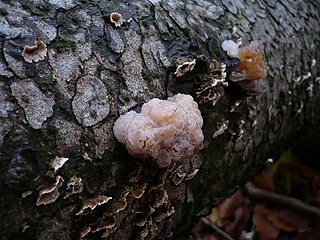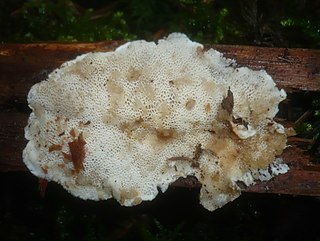
The Tremellomycetes are a class of dimorphic fungi in the Agaricomycotina. Some species have gelatinous basidiocarps or (microscopically) a sacculate parenthesome. There are six orders, 17 families, and 39 genera in the Tremellomycetes. Tremellomycetes include yeasts, dimorphic taxa, and species that form complex fruiting bodies. Tremellomycetes include some fungi that are human and animal pathogens in the genera Cryptococcus, Naganishia, Papiliotrema, and Trichosporon and some fungi that are cultivated for food in the genera Tremella and Naematelia.

The Tremellaceae are a family of fungi in the order Tremellales. The family is cosmopolitan and contains both teleomorphic and anamorphic species, most of the latter being yeasts. All teleomorphs in the Tremellaceae are parasites of other fungi, though the yeast states are widespread and not restricted to hosts. Basidiocarps, when produced, are gelatinous.

The Auriculariaceae are a family of fungi in the order Auriculariales. Species within the family were formerly referred to the "heterobasidiomycetes" or "jelly fungi", since many have gelatinous basidiocarps that produce spores on septate basidia. Around 100 species are known worldwide. All are believed to be saprotrophic, most growing on dead wood. Fruit bodies of several Auricularia species are cultivated for food on a commercial scale, especially in China.

The Tremellales are an order of fungi in the class Tremellomycetes. The order contains both teleomorphic and anamorphic species, most of the latter being yeasts. All teleomorphic species in the Tremellales are parasites of other fungi, though the yeast states are widespread and not restricted to hosts. Basidiocarps, when produced, are gelatinous.

Tremella is a genus of fungi in the family Tremellaceae. All Tremella species are parasites of other fungi and most produce anamorphic yeast states. Basidiocarps, when produced, are gelatinous and are colloquially classed among the "jelly fungi". Over 100 species of Tremella are currently recognized worldwide. One species, Tremella fuciformis, is commercially cultivated for food.
Bulleribasidium is a genus of fungi in the family Bulleribasidiaceae. The genus currently contains some eleven species. The type species is a parasite of other fungi, its teleomorph having septate basidia and haustorial cells on its hyphae that connect to the host hyphae. Most species are, however, only known from their yeast states.
Kwoniella is a genus of fungi in the family Cryptococcaceae. The genus originally contained the single species Kwoniella mangrovensis, found in the Florida Everglades and The Bahamas. Molecular research, based on cladistic analysis of DNA sequences, has however, now extended the genus to eleven species, most known only from their yeast states.
Papiliotrema is a genus of fungi in the family Rhynchogastremaceae. Filamentous states, where known, form septate basidia with haustorial cells indicating they are parasites of other fungi. Most species are currently known only from their yeast states. More than 20 species have been referred to Papiliotrema.

Phaeotremella is a genus of fungi in the family Phaeotremellaceae. All Phaeotremella species are parasites of other fungi and produce anamorphic yeast states. Basidiocarps, when produced, are gelatinous and are colloquially classed among the "jelly fungi". Fifteen or so species of Phaeotremella are currently recognized worldwide. Tremella sanguinea, shown to be a Phaeotremella species by DNA sequencing, is cultivated in China as an ingredient in traditional Chinese medicine.

Naematelia is a genus of fungi in the family Naemateliaceae. All Naematelia species are parasites of other fungi and produce anamorphic yeast states. When produced, Basidiocarps ,, are gelatinous and are colloquially classed among the "jelly fungi."Four species of Naematelia are currently recognized worldwide. One species, Naematelia aurantialba, is commercially cultivated for food.
Pseudotremella is a genus of fungi in the family Bulleraceae. All Pseudotremella species are parasites of other fungi and produce anamorphic yeast states. Basidiocarps, when produced, are gelatinous and are colloquially classed among the "jelly fungi". Four species of Pseudotremella are currently recognized worldwide. Two of these species are, as yet, only known from their yeast states.
The Naemateliaceae are a family of fungi in the order Tremellales. The family currently contains two genera.
The Phaeotremellaceae are a family of fungi in the order Tremellales. The family currently contains two genera.
The Cryptococcaceae are a family of fungi in the order Tremellales. The family currently contains two genera. Some species produce filamentous, sexual states with distinctive basidia and are parasites of other fungi. Most, however, are only known from their yeast states. Several species of Cryptococcus are human pathogens.
The Bulleraceae are a family of fungi in the order Tremellales. The family currently contains five genera. Some species produce gelatinous basidiocarps and were formerly placed in the genus Tremella. Most, however, are only known from their yeast states.
The Bulleribasidiaceae is a family of fungi in the order Tremellales.
The Rhynchogastremaceae are a family of fungi in the order Tremellales. The family currently contains two genera. Some species produce filamentous sexual states with septate basidia and are parasites of other fungi. Most, however, are only known from their yeast states.
The Trimorphomycetaceae are a family of fungi in the order Tremellales. The family currently contains four genera. Some species produce filamentous sexual states and are parasites of other fungi. Most, however, are only known from their yeast states.

The Carcinomycetaceae are a family of fungi in the order Tremellales. The family currently contains a single genus. Some species produce filamentous sexual states with basidia and are parasites of other fungi. Some, however, are only known from their yeast states.
Tremella yokohamensis is a species of fungus in the family Tremellaceae. It produces white, foliaceous, gelatinous basidiocarps and is parasitic on other fungi on dead wood of broad-leaved trees. It was originally described from Japan.







